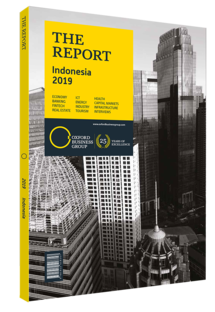Indonesia increases attempts to address urban traffic congestion
An estimated 4m people commute from Greater Jakarta into the city centre for work every day. Public transport has not matched the capital’s rapid growth in recent decades, leading to its international notoriety as a congested mega-city. With Jakarta representing about a fifth of all economic activity in Indonesia, congestion costs the economy an estimated $5bn per year. In response, the government has set the ambitious goal of having 60% of travellers use public transport in the capital by 2030, up from the current level of 23%. Key to the achievement of this target is the full operation of a 112-km mass rapid transit (MRT) system with more than 60 stations by 2025, the total cost of which is expected to exceed $7bn.
Vision
Jakarta administrators have envisaged an MRT system since the 1980s. It was not until 2008, however, that MRT Jakarta was established as a stateowned enterprise (SOE) under the Special Capital Region of Jakarta, also known as DKI Jakarta, to oversee the operation and construction of the system. Land acquisition began in 2009 and construction began in October 2013. The project has been designed and funded by Japanese companies, including the Japan International Cooperation Agency (JICA), which provided more than $2bn in soft loans for the first two phases. Delays in constructing the $3bn first phase of the project saw two top officials of the consortium responsible for its construction relieved of their duties in mid-2016. Phase one of the MRT, which spans 13 stations along 15.7 km from the southern Lebak Bulus neighbourhood to the city’s Hotel Indonesia roundabout in the business district, will transport 170,000 commuters a day. The president director of MRT Jakarta, William Sabandar, says it will reduce the travel time between Lebak Bulus and the city centre from 90 minutes to 30 minutes. Despite some challenges with land acquisition around the stations, the first phase began operations in March 2019. Phase two of the project was scheduled to begin in January 2019, with the aim of connecting the Hotel Indonesia roundabout to Kota Station in the city’s north-west by 2024. However, the groundbreaking was postponed until March 2019 due a lack of approval from the Ministry of State Secretariat. Kota Station is a major hub for trains in Jakarta and for travel to other parts of Java. A feasibility study by the JICA, a member of the project consortium, found that phase two would cost Rp25.1tn ($1.78bn). The second phase presents new challenges because it will be developed near areas of historical and political importance, such as the Bank Indonesia building and Presidential Palace complex. Phase three of the project, also known as the East-West line, is estimated to cost more than $4bn and will be opened up to more investors, reportedly attracting interest from the US, China and Europe.
Economic Multiplier
The new Soekarno-Hatta Airport Rail Link will connect to the MRT in addition to a light rail transit (LRT) system, producing a “nicely integrated rail system which integrates with the commuter rail system and the Trans-Jakarta bus system”, according to Julian Smith, global transport and logistics leader at PwC.
Property development is also growing around MRT stations, with Rp15trn ($1.1bn) of economic benefits from commercial and residential developments around each of the 13 stations. There are also plans to link stations directly with shopping malls. In Bogor, a satellite city 40 km south of Jakarta, an LRT City is under construction, boasting 12 apartment blocks, malls and offices over 15 ha of land. An LRT terminal is due to open in Bogor sometime in the 2020s. It is estimated that the MRT will transport 1m passengers a day by 2024, and it is expected to be fully operational by 2025. Although the construction work might cause some short-term pain and increased congestion, the establishment of efficient mass transit systems will provide long-term benefits for economic productivity and quality of life across the Greater Jakarta region.
You have reached the limit of premium articles you can view for free.
Choose from the options below to purchase print or digital editions of our Reports. You can also purchase a website subscription giving you unlimited access to all of our Reports online for 12 months.
If you have already purchased this Report or have a website subscription, please login to continue.

